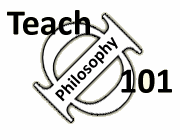Teach Philosophy 101
Free resources for
philosophy teachers!
"One of the most comprehensive, well-researched, and accessible guides for teachers that I have ever seen." James Lang, Chronicle of Higher Education (read full review of TΦ101)
Rubrics
A rubric is a tool for assessing student work that lists the criteria that will be used in evaluation (for papers this might be: thesis, organization, use of evidence, etc.) and also explains the differences in quality in each criterion (Andrache). Since most of our students have never read a philosophy paper before, let alone written one, it is hardly surprising that they don't know what makes a paper successful. Creating a rubric is a good way to help them understand what you are looking for before they start to write the paper. The rubric also saves enormous time in helping the professor explain to students why they earned a certain grade, and will likely generate more consistency in your grading (In other words, this is finally a suggestion that can actually save time) The best way to understand the concept is to look at some samples:
-
Lots of institutions make use of the VALUE rubrics developed by the American Association of Colleges and Universities. They can provide a good starting point.
-
Generic paper rubric from Kelly Bender, "What Does the Letter Grade Mean?" Assessment Update. 16.6 (2006):11.
-
Maralee Harrell (Carnegie Mellon University) has a detailed rubric specifically for grading philosophy papers. "Grading According to a Rubric," Teaching Philosophy, 28.1 (2005): 3-14 (See the article itself for the entire rubric). Villanova has a more holistic rubric for papers in the sense that it doesn't assign numerical weights to each category.
-
Perhaps the most detailed rubric we have seen for grading philosophy papers comes from Micah T. Lewin (GSU Perimeter College).
-
Rubrics can also be used for grading class participation, projects, or any other assignment.
-
Villanova has blog instructions and rubrics. Villanova also has a rubric for oral presentations as part of our discussion of using class presentations as assignments.
-
One recommendation, whatever rubric you adopt, is to assign a significant value to proper documentation and source usage if your goal is to receive the student's own work. This can be a way to cut off plagiarism issues at the pass. E.g., if 40% of the paper grade is proper documentation, then a paper without any documentation will not be able to receive a passing grade.
One problem with rubrics that TΦ101 has encountered is that students often don't read or comprehend the rubric before writing the paper. One way to circumvent this issue is to have students apply whatever rubric you adopt to sample papers in class or as a homework assignment. TΦ101 has also been experimenting with a simpler self-evaluation checklist, which may be easier for students to work with. You also use rubrics for the purposes of in class peer review of drafts: Students exchange papers and then provide each other feedback on the basis of the rubric (probably a good idea to avoid having them actually score the papers in this case).
Sources:
Heidi Goodrich Andrade, "Teaching with Rubrics: The Good Bad and the Ugly," College Teaching, 53. (2005) 27-30.
Dannelle D. Stevens and Antonia J. Levi, Introduction To Rubrics: An Assessment Tool To Save Grading Time, Convey Effective Feedback and Promote Student Learning. Stylus Publishing (2004)
Author: John Immerwahr
Update: June 14, 2017 (E. Tarver); 12/15/2025--David Sackris
